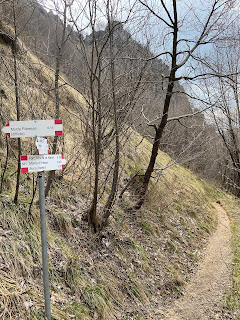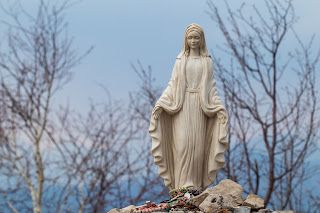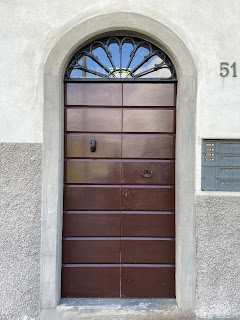




Top left: Trail 533 in Salmezza. Top center: A broken birch tree near Corna Bianca. Top right: Trail 531 marker. Bottom left: Hike tracks from Bergamo to Salmezza calling out trails 531 and 533. Bottom right: On Trail 533 below Salmezza.
Overview
Length: 31 km (19.2 mi)
Duration: ~9 hours (one 30 min stop for lunch, and two small stops)
Elevation: 1,640 m (5,380 ft)
Location: Italy, Lombardy, Parco dei Colli, Alzano Lombardo
Notes
Two weeks ago
we tried to reach Monte Filaressa and turned around due to stormy conditions. Today, we are able to make it to Monte Filaressa (1134 m) and beyond to Monte Costone (1195 m) and the flanks of Corna Bianca (1228 m). Our turn around point before returning to Bergamo is the small hamlet of
Salmezza. This hamlet is a good example of an alpine village.
To reach Salmezza, you can walk from Bergamo as we do here, or you can take a tram – bus – gondola combination to get to Selvino and then walk up. Or, you can drive. To be honest, this is a long walk. There are plenty of places to stop along the way to relax. We stopped at Canto Basso for a small break, then again at the top of Monte Filaressa for lunch, and then at Salmezza for a coffee (take-out only during pandemic). In our
hike to Salmezza last August, we ate at Merelli Gilberto. So that's a great option for lunch when things return to normal after the pandemic.
You can climb to the peak of Monte Filaressa, but must turn around to continue on toward Salmezza. As you are descending from Filaressa, you might be tempted by the first trail going off to the right, heading to Salmezza. Be warned that trail is very steep. If you continue down a little more, descending back toward Monte di Nese, you'll reach a easier and flatter trail that goes around the north of Monte Filaressa.
As a reminder, typical for these hikes, study before going:
CAI maps and
OpenStreetMap. There are trails that follow the crests, which can be a bit intimidating. There are usually alternate trails slightly lower (and longer) but just as satisfying. Trail signage gives indications to difficulty. For the path between Monte di Nese and Salmezza,
Trail 533 is your lower altitude trail and
Trail 531 is your crest trail. In today's hike we took Trail 531 going and Trail 533 returning.
Flora
Many of the resources we use are listed in our post
Resources for Identifying Plants around Bergamo. We especially rely on the
Checklist flora (for the Lombardy region) to check if the altitude we spotted the plant and the season of bloom are correct. Then, we double check in the half dozen guide books we have. In particular, the
Gruppo Flora Alpina Bergamasca have a series of really useful books.
On this hike, the Gentians were particular difficult to identify. We used the data at
Checklist Flora. We ruled out
G. acaulis (found above 2000 m, blooms starting in May, and looks like
G. clusii) and
G. bavarica (found above 1700 m, blooms starting in July, and looks like
G. verna). On this hike we didn't break 1200 m.
We give identifications in this form:
[Family] Genus species – Common name in English {Common name in Italian}
[Brassicaceae]
Alliaria petiolata – Garlic Mustard {
Alliaria comune}
[Brassicaceae]
Cardamine heptaphylla – Pinnate Coralroot {
Dentaria pennata}
- Note the seven (hepta) parts (leaflets) to the leaf.
[Caprifoliaceae]
Knautia arvensis – Field Scabiosa {
Ambretta comune}
[Ericaceae]
Erica carnea – Winter Heath, Spring Heath – {
Erica carnicina}
[Euphorbiaceae]
Euphorbia amygdaloides – Wood Spurge {
Euforbia mandorlo}
[Fabiaceae]
Laburnum anagyroides – Common Laburnum, Golden Rain/Chain {
Maggiociondolo}
- Didn't get a good photo of this, but was spotted at low elevations < 600 m.
[Gentianaceae]
Gentiana clusii – Trumpet Gentian {
Genziana di Clusius}
- Found above 1400m (we saw it between 900 – 1100 m, outside of reported range).
- Bloom starting April. (satisfied)
- No green inside corolla to distinguish between G. acaulis. (satisfied)
[Gentianaceae]
Gentiana utriculosa – Bladder Gentian {
Genziana alata}
- Found above 300 m (satisfied)
- Blooms starting in May (stretching it but we are almost in May)
[Gentianaceae]
Gentiana verna – Spring Gentian {
Genziana primaverile}
- Found above 400 m. (satisfied)
- Blooms starting April. (satisfied)
[Polygalaceae]
Polygaloides chamaebuxus – Shrubby Milkwort {
Poligala falso bosso, camebosso}
[Ranunculaceae]
Helleborus niger – Christmas rose {
Rosa di Natale}
[Rubiaceae]
Cruciata laevipes – Crosswort, Smooth Bedstraw {
Crocettona comune}
- Rubiaceae is a family of flowering plants, commonly known as the coffee, madder, or bedstraw family.
[Salicaceae]
Salix sp. – Willow {
Salice} – possibly
S. purpurea.
[Thymelaeaceae]
Daphne cneorum – Garland flower {
Dafne odorosa}
![[Brassicaceae] Alliaria petiolata – Garlic Mustard. [Brassicaceae] Alliaria petiolata – Garlic Mustard.](https://blogger.googleusercontent.com/img/b/R29vZ2xl/AVvXsEhIpqVvyYya98T2_WA2nkd48aWuW4pMqsvWRzAuhMdUtzZ-o9ZybiTYHhZ7ACebzBqgH4jTDxBu4njm9OcYiPhdMWAI0DNWKpfmhnHeT9LP9UNsf4mMYmeo0KeLP8a_sm2SfvkrWvGxMKU/s320/%255BBrassicaceae%255D+Allaria+petiolata+1.jpg)
![[Brassicaceae] Alliaria petiolata – Garlic Mustard. [Brassicaceae] Alliaria petiolata – Garlic Mustard.](https://blogger.googleusercontent.com/img/b/R29vZ2xl/AVvXsEgTBfCzUt869D1hEdQTtZ7C0YDlXLnGK7jAsbnFGtXsZmoZDPurxoql9LImOZdhC6KGMgAoBmeJ8_6is-slz1HRWji3iC0herk0gW-V5QKik4k4PeyK4RcSJJF74Is5JRW18BMbPFfZNuo/s320/%255BBrassicaceae%255D+Allaria+petiolata+2.jpg)
![[Brassicaceae] Cardamine heptaphylla – Pinnate Coralroot. [Brassicaceae] Cardamine heptaphylla – Pinnate Coralroot.](https://blogger.googleusercontent.com/img/b/R29vZ2xl/AVvXsEjySmGRybQhjoQxhFwCeeAggbokeDqRjWmnIkhmJdgFnqXb_w9sQPIEYAxm7Tri1J8BPUjUueABi2VVztSz1DeK_Lrgrtrvw5Cub0MKsaSxNNGmLtiWDdfUnsuMXGe8IFwzkmcLxZ2K-kI/s320/%255BBrassicaceae%255D+Cardamine+heptaphylla+1.jpg)
Left and center: [Brassicaceae] Alliaria petiolata – Garlic Mustard. Right: [Brassicaceae] Cardamine heptaphylla – Pinnate Coralroot.
![[Brassicaceae] Cardamine heptaphylla – Pinnate Coralroot. [Brassicaceae] Cardamine heptaphylla – Pinnate Coralroot.](https://blogger.googleusercontent.com/img/b/R29vZ2xl/AVvXsEgfQ8xBSU0GIAONcAY-Hk0S04TANObxmX7g4a0KebVKBzDAxW1_kJYC43eI_efjubwq5_U0gS17UAmZUeE_-pWlY73ye9f_5m-fVqMGDZtaWenk4pHoFVE4tCb_cp2YKyA6al3lNvGt-Yk/s320/%255BBrassicaceae%255D+Cardamine+heptaphylla+2.jpg)
![[Brassicaceae] Cardamine heptaphylla – Pinnate Coralroot. [Brassicaceae] Cardamine heptaphylla – Pinnate Coralroot.](https://blogger.googleusercontent.com/img/b/R29vZ2xl/AVvXsEia-B7xV99OlXIBjnoIIIXCg_nIZTxWNgcI9INoeqI4PRlBO2W6F9EXbKe4ZBTIhxiXyRskKy364Gsm8szN4oWRoDJq9wBzds1nC1stSy1DKzTMloqvlkt59clVY2POCLh82yqNhnLzdyU/s320/%255BBrassicaceae%255D+Cardamine+heptaphylla+3.jpg)
[Brassicaceae] Cardamine heptaphylla – Pinnate Coralroot.
![[Caprifoliaceae] Knautia arvensis – Field Scabiosa. [Caprifoliaceae] Knautia arvensis – Field Scabiosa.](https://blogger.googleusercontent.com/img/b/R29vZ2xl/AVvXsEh1LG2KUTwquoPU_-WuXyeuTNwqGIx6xzBGxHiy8Fr96EJfA404A9kKRZ8MNZQpt5s5JVGZBan0UUCxz8TYzkwWL5j8hFVX4PckhLXv4Y8HHqQPjdgKvRHJ1V7_fO6K5ePa_iI1_hhXhk4/s320/%255BCaprifoliaceae%255D+Knautia+arvensis.jpg)
![[Ericaceae] Erica carnea – Winter Heath, Spring Heath. [Ericaceae] Erica carnea – Winter Heath, Spring Heath.](https://blogger.googleusercontent.com/img/b/R29vZ2xl/AVvXsEhukaiXOPln7mkB5f5IFWS7omHpWQdwUxDjUIys9V2_AWTcWGosS3jsDUrIwOC5uX3eMXQrhsYKRlkn0E37KJht02FNulk_DZN-hvM2vuEjo6jjqtUHTc6G6cDbCwF974IUtk4Yxs04yLQ/s320/%255BEricaceae%255D+Erica+carnea.jpg)
Left: [Caprifoliaceae] Knautia arvensis – Field Scabiosa. Right: [Ericaceae] Erica carnea – Winter Heath, Spring Heath.
![[Euphorbiaceae] Euphorbia amygdaloides. [Euphorbiaceae] Euphorbia amygdaloides.](https://blogger.googleusercontent.com/img/b/R29vZ2xl/AVvXsEg2xaovP1ySZioElSDDPCq3YpX1aJiWwU7Uc7UmJ4ujereFcfblPjgKonXEIk34PutxO9ZcCFyNZDd05gNJsnvZi7pI2J97b-9xbSaiMa6hFk7yKYl8gYu6zMyPBKXX-jto63qx_uIthP8/s320/%255BEuphorbiaceae%255D+Euphorbia+amygdaloides.jpg)
![[Rubiaceae] Cruciata laevipes – Crosswort, Smooth Bedstraw. [Rubiaceae] Cruciata laevipes – Crosswort, Smooth Bedstraw.](https://blogger.googleusercontent.com/img/b/R29vZ2xl/AVvXsEj_5DVD0Ww1pa3z4zskdHJ3tGvXrsVNd4MB0hzxmwf10g2A8t5D8DHIf2t0gSsd0aDRGKwIARfeNAAckX1pAFuVI0QwUqnAKJ-IkjTxQPnzIuuhVde8VH0AjNSBSChyphenhyphenuIl4k7jHXk5jowU/s320/%255BRubiaceae%255D+Cruciata+laevipes.jpg)
Left: [Euphorbiaceae] Euphorbia amygdaloides. Right: [Rubiaceae] Cruciata laevipes – Crosswort, Smooth Bedstraw.
![[Gentianaceae] Gentiana clusii – Trumpet Gentian. [Gentianaceae] Gentiana clusii – Trumpet Gentian.](https://blogger.googleusercontent.com/img/b/R29vZ2xl/AVvXsEjWrcO_jWcOqSxcXgcMOKQKXnOl5WDbaMfkGEQ-1VxYtyAAc6xzzUEVj3uZrpQqVMvNa4Hur8cLxEuZ3pkaQQ4RsFy21LXNb2FTS8BWzFBj0Q1SNogegHqbi-qk3DJSgz-qnoJw4pWo20M/s320/%255BGentianaceae%255D+Gentiana+clusii+1.jpg)
![[Gentianaceae] Gentiana clusii – Trumpet Gentian. [Gentianaceae] Gentiana clusii – Trumpet Gentian.](https://blogger.googleusercontent.com/img/b/R29vZ2xl/AVvXsEiiZBRo3T_Hv5FlcL_tM97Mt69YhksFUeXGzYPSjw_HrniQkN6TVdec-XaSJSxV5YtPyy5U25sKIGDUrJT5qmli_y2PL0g4rYLwEr8LGdIcEfdTsIaQptaTV9zoqFhmVJNPB5hpXT-Q630/s320/%255BGentianaceae%255D+Gentiana+clusii+2.jpg)
[Gentianaceae] Gentiana clusii – Trumpet Gentian.
![[Gentianaceae] Gentiana utriculosa – Bladder Gentian. [Gentianaceae] Gentiana utriculosa – Bladder Gentian.](https://blogger.googleusercontent.com/img/b/R29vZ2xl/AVvXsEiASdlb47VyYNohYkpM-12RR9ccG0S1aQYojP7f_-z755U90Dw5pzjhHOEEVTdEleop4NTe2LDqYJArO3D-1A_xuaYlYr6NIshDPzC6P9U9-t89kg8dRenLVewGa9O055wjsgw1hlDfwnA/s320/%255BGentianaceae%255D+Gentiana+utriculosa+1.jpg)
![[Gentianaceae] Gentiana utriculosa – Bladder Gentian. [Gentianaceae] Gentiana utriculosa – Bladder Gentian.](https://blogger.googleusercontent.com/img/b/R29vZ2xl/AVvXsEitCffkKBW3oEIOjMJ6vXqJHf14zBGBaub8x3aD4hd5NOruA-QFSGrlOR2iZ6DDp13MntYJAMo6bbJjEokI1xxZn1d0_MiPogQgPFnmPVnybd1e654vufvJ3Lnc8LfqDweqOfCXpfaXijM/s320/%255BGentianaceae%255D+Gentiana+utriculosa+2.jpg)
[Gentianaceae] Gentiana utriculosa – Bladder Gentian.
![[Gentianaceae] Gentiana verna – Spring Gentian. [Gentianaceae] Gentiana verna – Spring Gentian.](https://blogger.googleusercontent.com/img/b/R29vZ2xl/AVvXsEiYe9qNfOc-sze9GujaNCymUkdwfqaBbSi_RhYci_j62AQ__pNy0_E9oJ0iHcUYMNBB98HwePsi_JnC_jTlxdeTeIvQ4N_bvjLGI-wA_gQtTklGMwTqk6slWIsLZ1AmuZrKaZrINIx1b3k/s320/%255BGentianaceae%255D+Gentiana+verna+1.jpg)
![[Gentianaceae] Gentiana verna – Spring Gentian. [Gentianaceae] Gentiana verna – Spring Gentian.](https://blogger.googleusercontent.com/img/b/R29vZ2xl/AVvXsEiMOOtmwv_hkUHpiPRW5AolDNKnIs_FK0Y7oNCVlUr3moRCHireNITCsLzhWKyq6s-FeVfQ6s0NRPMpFUF5Amr-SfgYrBvKJy-75IS5B4-l-dklFcu1dzcdLyhTc4mq6vj5KvsyUoawV2k/s320/%255BGentianaceae%255D+Gentiana+verna+2.jpg)
[Gentianaceae] Gentiana verna – Spring Gentian.
![[Polygalaceae] Polygaloides chamaebuxus – Shrubby Milkwort. [Polygalaceae] Polygaloides chamaebuxus – Shrubby Milkwort.](https://blogger.googleusercontent.com/img/b/R29vZ2xl/AVvXsEgUCazP1Gy61Absn7eUAVyMZj4X5-IjKXuhW6rMWARN5LBxBdcyouWOGICUgmTUYS1Ys9RZJ8E-h9FjcrDaLNrW9HNlGtJAjmxJ6NU9YasV94_N8rqa2wiF4kyN3Bt7se7dW2Foh5kfJrE/s320/%255BPolygalaceae%255D+Polygaloides+chamaebuxus+1.jpg)
![[Polygalaceae] Polygaloides chamaebuxus – Shrubby Milkwort. [Polygalaceae] Polygaloides chamaebuxus – Shrubby Milkwort.](https://blogger.googleusercontent.com/img/b/R29vZ2xl/AVvXsEgCh6pGFgdyVhxZTyUTKHN4YTXJNpn6rhSs72GZ8OxSw-opfMMhesIPefS0WsO-E-Llk5H7XzUyO00ym_IeQdrRNyiU9Gn3fMj1dLYHq1V4uGU8M9MvMuZmZzAPz0w-kCvY72Hr0wyBh1c/s320/%255BPolygalaceae%255D+Polygaloides+chamaebuxus+2.jpg)
[Polygalaceae] Polygaloides chamaebuxus – Shrubby Milkwort.
![[Ranunculaceae] Helleborus niger – Christmas rose. [Ranunculaceae] Helleborus niger – Christmas rose.](https://blogger.googleusercontent.com/img/b/R29vZ2xl/AVvXsEjBz5QWAlrtrcSW4OKyuwSAqvbIXpNCfFUcQb2-j6mPKoFuz9KgHjH7m1zJRQ09wp9h_cbbjsY1IIWbDp-4qJdTk1Vv1c-JyU66Lqfye-VDHhD6IfsyHbhzQLBtnRGjNArGGYdc9d1Of_Q/s320/%255BRanunculaceae%255D+Helleborus+niger.jpg)
![[Thymelaeaceae] Daphne cneorum – Garland flower. [Thymelaeaceae] Daphne cneorum – Garland flower.](https://blogger.googleusercontent.com/img/b/R29vZ2xl/AVvXsEgW8Z3hzZsO6oKdNg72P2aqiLxJQbBPgCPCIvWkLctSaKdyu4Y2_z3GB0ZljjO-qLaMkH9UWJBFBn5-zXXOgc2RlJtNK2AePlE3r3JjPIy5Kv4kYvQFPAVc1Ok6g5EueIKmcyfXiUyky3E/s320/%255BThymelaeaceae%255D+Daphne+ceneorum+1.jpg)
![[Thymelaeaceae] Daphne cneorum – Garland flower. [Thymelaeaceae] Daphne cneorum – Garland flower.](https://blogger.googleusercontent.com/img/b/R29vZ2xl/AVvXsEhxMCUFAs2zUDHy4vXl2XvJBE3K02f2UQxdwA5cNihDnshet3s-H9UOKmy23_Qei9-CKYHrI-JaU6Lv5BwgS-p5AF8saCdw_dwYaTxkG2F_OjMiEd3lbU84Z3s5W1jUGtdCc5Vdabhk-L0/s320/%255BThymelaeaceae%255D+Daphne+ceneorum+2.jpg)
Left: [Ranunculaceae] Helleborus niger – Christmas rose. Center and right: [Thymelaeaceae] Daphne cneorum – Garland flower.
![[Salicaceae] Salix sp. – Willow. [Salicaceae] Salix sp. – Willow.](https://blogger.googleusercontent.com/img/b/R29vZ2xl/AVvXsEgryR9rsUFDr0t1dhW_mZm2PIcvRGPvwlv93ZPPPc_dHYWTh-zPoa3MWrsu7jyItAORUtd-sMKGrz6UipsWbr2w9iAPgx3g5HCG8DtSkc2ngg9ovEZUN_oiaHbfxWKBGtEv3oHpO8XPIAY/s320/%255BSalicaceae%255D+Salix+1.jpg)
![[Salicaceae] Salix sp. – Willow. [Salicaceae] Salix sp. – Willow.](https://blogger.googleusercontent.com/img/b/R29vZ2xl/AVvXsEhPyYgJwbeWzKFg5Jg0sWFTtYK1YeC3DEKeac7hPuFuldB9d8iIIbW9cDhjtrlKFqd_aJshoRDZ3KMa6OVkIsmFNPiS5sRNOeTS4wIzN7prr8yRdT7u5IFwOHb-jtZdfw-ItbPVzR7qfOY/s320/%255BSalicaceae%255D+Salix+2.jpg)
[Salicaceae] Salix sp. – Willow.
Trail Photos


Left: Above Monte di Nese, walking toward Monte Filaressa. Right: Canto Basso, walking toward Monte Cavallo.



Left: The hike tracks (without annotation). Center: Trail north of Monte Filaressa that skirts the peak. Right: Madonna del Riposo overlooking Selvino.


Left: Madonnina of Monte Costone. Right: Leaving the Madonnina and heading to Corna Bianca on the crest trail.


Left: The flanks of Monte Filaressa heading up to the peak. Right: From the flanks of Monte Filaressa looking south toward Monte di Nese.


Left: Trail 533 below Monte di Nese with profile of Monte Filaressa in the background. Right: View of the alpine village of Salmezza from Corna Bianca.














































![[Brassicaceae] Alliaria petiolata – Garlic Mustard. [Brassicaceae] Alliaria petiolata – Garlic Mustard.](https://blogger.googleusercontent.com/img/b/R29vZ2xl/AVvXsEhIpqVvyYya98T2_WA2nkd48aWuW4pMqsvWRzAuhMdUtzZ-o9ZybiTYHhZ7ACebzBqgH4jTDxBu4njm9OcYiPhdMWAI0DNWKpfmhnHeT9LP9UNsf4mMYmeo0KeLP8a_sm2SfvkrWvGxMKU/s320/%255BBrassicaceae%255D+Allaria+petiolata+1.jpg)
![[Brassicaceae] Alliaria petiolata – Garlic Mustard. [Brassicaceae] Alliaria petiolata – Garlic Mustard.](https://blogger.googleusercontent.com/img/b/R29vZ2xl/AVvXsEgTBfCzUt869D1hEdQTtZ7C0YDlXLnGK7jAsbnFGtXsZmoZDPurxoql9LImOZdhC6KGMgAoBmeJ8_6is-slz1HRWji3iC0herk0gW-V5QKik4k4PeyK4RcSJJF74Is5JRW18BMbPFfZNuo/s320/%255BBrassicaceae%255D+Allaria+petiolata+2.jpg)
![[Brassicaceae] Cardamine heptaphylla – Pinnate Coralroot. [Brassicaceae] Cardamine heptaphylla – Pinnate Coralroot.](https://blogger.googleusercontent.com/img/b/R29vZ2xl/AVvXsEjySmGRybQhjoQxhFwCeeAggbokeDqRjWmnIkhmJdgFnqXb_w9sQPIEYAxm7Tri1J8BPUjUueABi2VVztSz1DeK_Lrgrtrvw5Cub0MKsaSxNNGmLtiWDdfUnsuMXGe8IFwzkmcLxZ2K-kI/s320/%255BBrassicaceae%255D+Cardamine+heptaphylla+1.jpg)
![[Brassicaceae] Cardamine heptaphylla – Pinnate Coralroot. [Brassicaceae] Cardamine heptaphylla – Pinnate Coralroot.](https://blogger.googleusercontent.com/img/b/R29vZ2xl/AVvXsEgfQ8xBSU0GIAONcAY-Hk0S04TANObxmX7g4a0KebVKBzDAxW1_kJYC43eI_efjubwq5_U0gS17UAmZUeE_-pWlY73ye9f_5m-fVqMGDZtaWenk4pHoFVE4tCb_cp2YKyA6al3lNvGt-Yk/s320/%255BBrassicaceae%255D+Cardamine+heptaphylla+2.jpg)
![[Brassicaceae] Cardamine heptaphylla – Pinnate Coralroot. [Brassicaceae] Cardamine heptaphylla – Pinnate Coralroot.](https://blogger.googleusercontent.com/img/b/R29vZ2xl/AVvXsEia-B7xV99OlXIBjnoIIIXCg_nIZTxWNgcI9INoeqI4PRlBO2W6F9EXbKe4ZBTIhxiXyRskKy364Gsm8szN4oWRoDJq9wBzds1nC1stSy1DKzTMloqvlkt59clVY2POCLh82yqNhnLzdyU/s320/%255BBrassicaceae%255D+Cardamine+heptaphylla+3.jpg)
![[Caprifoliaceae] Knautia arvensis – Field Scabiosa. [Caprifoliaceae] Knautia arvensis – Field Scabiosa.](https://blogger.googleusercontent.com/img/b/R29vZ2xl/AVvXsEh1LG2KUTwquoPU_-WuXyeuTNwqGIx6xzBGxHiy8Fr96EJfA404A9kKRZ8MNZQpt5s5JVGZBan0UUCxz8TYzkwWL5j8hFVX4PckhLXv4Y8HHqQPjdgKvRHJ1V7_fO6K5ePa_iI1_hhXhk4/s320/%255BCaprifoliaceae%255D+Knautia+arvensis.jpg)
![[Ericaceae] Erica carnea – Winter Heath, Spring Heath. [Ericaceae] Erica carnea – Winter Heath, Spring Heath.](https://blogger.googleusercontent.com/img/b/R29vZ2xl/AVvXsEhukaiXOPln7mkB5f5IFWS7omHpWQdwUxDjUIys9V2_AWTcWGosS3jsDUrIwOC5uX3eMXQrhsYKRlkn0E37KJht02FNulk_DZN-hvM2vuEjo6jjqtUHTc6G6cDbCwF974IUtk4Yxs04yLQ/s320/%255BEricaceae%255D+Erica+carnea.jpg)
![[Euphorbiaceae] Euphorbia amygdaloides. [Euphorbiaceae] Euphorbia amygdaloides.](https://blogger.googleusercontent.com/img/b/R29vZ2xl/AVvXsEg2xaovP1ySZioElSDDPCq3YpX1aJiWwU7Uc7UmJ4ujereFcfblPjgKonXEIk34PutxO9ZcCFyNZDd05gNJsnvZi7pI2J97b-9xbSaiMa6hFk7yKYl8gYu6zMyPBKXX-jto63qx_uIthP8/s320/%255BEuphorbiaceae%255D+Euphorbia+amygdaloides.jpg)
![[Rubiaceae] Cruciata laevipes – Crosswort, Smooth Bedstraw. [Rubiaceae] Cruciata laevipes – Crosswort, Smooth Bedstraw.](https://blogger.googleusercontent.com/img/b/R29vZ2xl/AVvXsEj_5DVD0Ww1pa3z4zskdHJ3tGvXrsVNd4MB0hzxmwf10g2A8t5D8DHIf2t0gSsd0aDRGKwIARfeNAAckX1pAFuVI0QwUqnAKJ-IkjTxQPnzIuuhVde8VH0AjNSBSChyphenhyphenuIl4k7jHXk5jowU/s320/%255BRubiaceae%255D+Cruciata+laevipes.jpg)
![[Gentianaceae] Gentiana clusii – Trumpet Gentian. [Gentianaceae] Gentiana clusii – Trumpet Gentian.](https://blogger.googleusercontent.com/img/b/R29vZ2xl/AVvXsEjWrcO_jWcOqSxcXgcMOKQKXnOl5WDbaMfkGEQ-1VxYtyAAc6xzzUEVj3uZrpQqVMvNa4Hur8cLxEuZ3pkaQQ4RsFy21LXNb2FTS8BWzFBj0Q1SNogegHqbi-qk3DJSgz-qnoJw4pWo20M/s320/%255BGentianaceae%255D+Gentiana+clusii+1.jpg)
![[Gentianaceae] Gentiana clusii – Trumpet Gentian. [Gentianaceae] Gentiana clusii – Trumpet Gentian.](https://blogger.googleusercontent.com/img/b/R29vZ2xl/AVvXsEiiZBRo3T_Hv5FlcL_tM97Mt69YhksFUeXGzYPSjw_HrniQkN6TVdec-XaSJSxV5YtPyy5U25sKIGDUrJT5qmli_y2PL0g4rYLwEr8LGdIcEfdTsIaQptaTV9zoqFhmVJNPB5hpXT-Q630/s320/%255BGentianaceae%255D+Gentiana+clusii+2.jpg)
![[Gentianaceae] Gentiana utriculosa – Bladder Gentian. [Gentianaceae] Gentiana utriculosa – Bladder Gentian.](https://blogger.googleusercontent.com/img/b/R29vZ2xl/AVvXsEiASdlb47VyYNohYkpM-12RR9ccG0S1aQYojP7f_-z755U90Dw5pzjhHOEEVTdEleop4NTe2LDqYJArO3D-1A_xuaYlYr6NIshDPzC6P9U9-t89kg8dRenLVewGa9O055wjsgw1hlDfwnA/s320/%255BGentianaceae%255D+Gentiana+utriculosa+1.jpg)
![[Gentianaceae] Gentiana utriculosa – Bladder Gentian. [Gentianaceae] Gentiana utriculosa – Bladder Gentian.](https://blogger.googleusercontent.com/img/b/R29vZ2xl/AVvXsEitCffkKBW3oEIOjMJ6vXqJHf14zBGBaub8x3aD4hd5NOruA-QFSGrlOR2iZ6DDp13MntYJAMo6bbJjEokI1xxZn1d0_MiPogQgPFnmPVnybd1e654vufvJ3Lnc8LfqDweqOfCXpfaXijM/s320/%255BGentianaceae%255D+Gentiana+utriculosa+2.jpg)
![[Gentianaceae] Gentiana verna – Spring Gentian. [Gentianaceae] Gentiana verna – Spring Gentian.](https://blogger.googleusercontent.com/img/b/R29vZ2xl/AVvXsEiYe9qNfOc-sze9GujaNCymUkdwfqaBbSi_RhYci_j62AQ__pNy0_E9oJ0iHcUYMNBB98HwePsi_JnC_jTlxdeTeIvQ4N_bvjLGI-wA_gQtTklGMwTqk6slWIsLZ1AmuZrKaZrINIx1b3k/s320/%255BGentianaceae%255D+Gentiana+verna+1.jpg)
![[Gentianaceae] Gentiana verna – Spring Gentian. [Gentianaceae] Gentiana verna – Spring Gentian.](https://blogger.googleusercontent.com/img/b/R29vZ2xl/AVvXsEiMOOtmwv_hkUHpiPRW5AolDNKnIs_FK0Y7oNCVlUr3moRCHireNITCsLzhWKyq6s-FeVfQ6s0NRPMpFUF5Amr-SfgYrBvKJy-75IS5B4-l-dklFcu1dzcdLyhTc4mq6vj5KvsyUoawV2k/s320/%255BGentianaceae%255D+Gentiana+verna+2.jpg)
![[Polygalaceae] Polygaloides chamaebuxus – Shrubby Milkwort. [Polygalaceae] Polygaloides chamaebuxus – Shrubby Milkwort.](https://blogger.googleusercontent.com/img/b/R29vZ2xl/AVvXsEgUCazP1Gy61Absn7eUAVyMZj4X5-IjKXuhW6rMWARN5LBxBdcyouWOGICUgmTUYS1Ys9RZJ8E-h9FjcrDaLNrW9HNlGtJAjmxJ6NU9YasV94_N8rqa2wiF4kyN3Bt7se7dW2Foh5kfJrE/s320/%255BPolygalaceae%255D+Polygaloides+chamaebuxus+1.jpg)
![[Polygalaceae] Polygaloides chamaebuxus – Shrubby Milkwort. [Polygalaceae] Polygaloides chamaebuxus – Shrubby Milkwort.](https://blogger.googleusercontent.com/img/b/R29vZ2xl/AVvXsEgCh6pGFgdyVhxZTyUTKHN4YTXJNpn6rhSs72GZ8OxSw-opfMMhesIPefS0WsO-E-Llk5H7XzUyO00ym_IeQdrRNyiU9Gn3fMj1dLYHq1V4uGU8M9MvMuZmZzAPz0w-kCvY72Hr0wyBh1c/s320/%255BPolygalaceae%255D+Polygaloides+chamaebuxus+2.jpg)
![[Ranunculaceae] Helleborus niger – Christmas rose. [Ranunculaceae] Helleborus niger – Christmas rose.](https://blogger.googleusercontent.com/img/b/R29vZ2xl/AVvXsEjBz5QWAlrtrcSW4OKyuwSAqvbIXpNCfFUcQb2-j6mPKoFuz9KgHjH7m1zJRQ09wp9h_cbbjsY1IIWbDp-4qJdTk1Vv1c-JyU66Lqfye-VDHhD6IfsyHbhzQLBtnRGjNArGGYdc9d1Of_Q/s320/%255BRanunculaceae%255D+Helleborus+niger.jpg)
![[Thymelaeaceae] Daphne cneorum – Garland flower. [Thymelaeaceae] Daphne cneorum – Garland flower.](https://blogger.googleusercontent.com/img/b/R29vZ2xl/AVvXsEgW8Z3hzZsO6oKdNg72P2aqiLxJQbBPgCPCIvWkLctSaKdyu4Y2_z3GB0ZljjO-qLaMkH9UWJBFBn5-zXXOgc2RlJtNK2AePlE3r3JjPIy5Kv4kYvQFPAVc1Ok6g5EueIKmcyfXiUyky3E/s320/%255BThymelaeaceae%255D+Daphne+ceneorum+1.jpg)
![[Thymelaeaceae] Daphne cneorum – Garland flower. [Thymelaeaceae] Daphne cneorum – Garland flower.](https://blogger.googleusercontent.com/img/b/R29vZ2xl/AVvXsEhxMCUFAs2zUDHy4vXl2XvJBE3K02f2UQxdwA5cNihDnshet3s-H9UOKmy23_Qei9-CKYHrI-JaU6Lv5BwgS-p5AF8saCdw_dwYaTxkG2F_OjMiEd3lbU84Z3s5W1jUGtdCc5Vdabhk-L0/s320/%255BThymelaeaceae%255D+Daphne+ceneorum+2.jpg)
![[Salicaceae] Salix sp. – Willow. [Salicaceae] Salix sp. – Willow.](https://blogger.googleusercontent.com/img/b/R29vZ2xl/AVvXsEgryR9rsUFDr0t1dhW_mZm2PIcvRGPvwlv93ZPPPc_dHYWTh-zPoa3MWrsu7jyItAORUtd-sMKGrz6UipsWbr2w9iAPgx3g5HCG8DtSkc2ngg9ovEZUN_oiaHbfxWKBGtEv3oHpO8XPIAY/s320/%255BSalicaceae%255D+Salix+1.jpg)
![[Salicaceae] Salix sp. – Willow. [Salicaceae] Salix sp. – Willow.](https://blogger.googleusercontent.com/img/b/R29vZ2xl/AVvXsEhPyYgJwbeWzKFg5Jg0sWFTtYK1YeC3DEKeac7hPuFuldB9d8iIIbW9cDhjtrlKFqd_aJshoRDZ3KMa6OVkIsmFNPiS5sRNOeTS4wIzN7prr8yRdT7u5IFwOHb-jtZdfw-ItbPVzR7qfOY/s320/%255BSalicaceae%255D+Salix+2.jpg)










